Download the PDF: 214kb - EcoSanRes
Download the PDF: 214kb - EcoSanRes
Download the PDF: 214kb - EcoSanRes
You also want an ePaper? Increase the reach of your titles
YUMPU automatically turns print PDFs into web optimized ePapers that Google loves.
<strong>EcoSanRes</strong> Fact Sheet 11Sweden-ChinaErdos Eco-Town ProjectDongsheng, Inner MongoliaBackgroundTo show that it is possible to build andoperate an urban community withsustainable approaches to sanitation,water use, solid waste management andinfrastructure, a bold new project hasbeen initiated by <strong>the</strong> Dongsheng Districtin Erdos Municipality, Inner MongoliaAutonomous Region, China. The city, inpartnership with a private constructioncompany, has collaborated with <strong>the</strong> Sidafinanced<strong>EcoSanRes</strong> Programme in <strong>the</strong>development of a new town with four andfive-storey buildings, a nursery schooland a commercial centre. Phase 1 includes825 apartments, on-site ecostation andgreywater treatment system and wascompleted in 2006. All phase 1apartments have been sold at market priceand families are taking up residence. Thiseco-town represents <strong>the</strong> first majorattempt in China - and <strong>the</strong> world - to buildan entire town applying on-site ecologicalsanitation (ecosan).Exterior (top) and interior (bottom) ofan urban public pit latrine, DongshengIntroductionDongsheng, on <strong>the</strong> Erdos Plateau of InnerMongolia, is located in Nor<strong>the</strong>rn China, ina region well endowed with minerals andespecially rich in coal and natural gasdeposits. The economy is developingrapidly, urban expansion and reconstructionis omnipresent, and housing is ingreat demand. However, <strong>the</strong> environmentalconditions are fragile, especially inregard to freshwater resources. The areareceives an annual precipitation of 300-400 mm with an evapo-transpirationpotential of about 2,800 mm and waterrationing is commonplace. The populationof Dongsheng is over 300,000 and <strong>the</strong>eco-town site (Hei Zao Kui) is only a fewkilometres from its centre.In downtown Dongsheng <strong>the</strong>re are about60,000 households, 15,000 in multi-storeyand 45,000 in single-storey buildings, ofwhich 1/3 have private flush toilets and2/3 use public toilets. There are nearly300 public toilets, of which 56% are deeppit latrines, 38% are shallow pit latrines,and 6% are flush toilets. In <strong>the</strong> peri-urbanand rural areas most households haveprivate, shallow pit latrines – most ofwhich are in miserable condition. Opendefecation is common. The sanitationsituation in Dongsheng and vicinity istypical for China as a whole, a patchworkof facilities that are poorly maintainedleading to poor human health, groundwaterpathogen contamination, nutrientpollution and environmental stress.Indeed, <strong>the</strong> poor sanitation conditions puta high toll on <strong>the</strong> already stressedfreshwater resources.Sewage conditionsPrior to 1985, when collector pipes wereintroduced to <strong>the</strong> city centre, householdsewage, including flush toilet waste, wasjointly discharged with storm waterthrough open trenches. In 2002 <strong>the</strong> firstsewage treatment plant was put inoperation with a daily capacity of 30,000tons, but due to inadequate collector pipes<strong>the</strong> volume treated is lower. The currentpractices contribute to polluting <strong>the</strong>groundwater and <strong>the</strong>re are obvious needsfor a sustainable system that preventspollution and conserves water. It isagainst this background that <strong>the</strong> city istesting ecosan in multi-storey buildings.The Eco-TownThe ecosan project is a unique privatepublicpartnership in which a privatedeveloper has adapted a sustainable sanitationapproach in a real estate businessventure in return for access to a particularparcel of land and a government taxrebate. Demonstration, training and stateof-<strong>the</strong>-artecosan knowledge is offered by<strong>the</strong> <strong>EcoSanRes</strong> Programme. The R&Decosan support relates to technical solutions,management aspects, institutionaldimensions, community sensitisation,policy promotion, cost-benefit analysesand monitoring. More information about<strong>the</strong> urban ecosan development in Dongshengcan be found at www.ecosanres.org.The ecosan town is equipped with modernporcelain toilets and urinals. The urinediversion,dry toilets and urinals usestandards developed and applied inSweden and in China. The sanitationfixtures and related equipment aredeveloped and manufactured in Chinaespecially for this project and nowavailable on <strong>the</strong> Chinese market. Urine iscollected and stored on-site in undergroundbrick and cement tanks made withlocal materials and subsequently used inlocal agriculture.Eco-Town Facts• 825 apartments in multi-storeybuildings – phase 1 completed in2006• nursery school for 900 children and100 staff plus public service centre• dry urine-diversion toilets andurinals for collection and reuse ofurine and dry faecal collection forcontainment, sanitisation andreuse• greywater is treated on-site andreused• household organics are collected,composted and reused• solid waste source-separation andrecycling• greywater treatment, <strong>the</strong>rmalcomposting and solid wastesorting takes place in an on-siteecostation• <strong>the</strong> entire operation, includingmanagement and communicationwith <strong>the</strong> households, is carried outby a local ecosan team
training for enhanced understanding andknowledge is offered to managementteam members, operators, governmentofficials and o<strong>the</strong>rs from <strong>the</strong> localcommunity and beyond. The apartmentowner-residents also undergo training forawareness and understanding of <strong>the</strong> ecotownmeasures.Apartment BuildingsFaeces collection binsUrine-diverting porcelain toiletStraight-drop urine diversion toiletdesignFaecal material is retained in dry form inplastic bin containers, removed from <strong>the</strong>building basements and composted andsanitised along with household organicsin <strong>the</strong> on-site ecostation for reuse as soilimprovement. Thus, <strong>the</strong> community isoffered sanitation services that workwithout water, while <strong>the</strong> water andnutrient cycles are being closed.Water supply is restricted to kitchen andbath use and designed at about 80 litres/person/day. The greywater is collectedand treated on-site in a septic tankincluding aeration, post-chlorination andstorage pond prior to reuse and surfacesoildischarge during <strong>the</strong> winter months.Storm and runoff water is drained along<strong>the</strong> natural contours of <strong>the</strong> landscapewithout any mixing with <strong>the</strong> householdproducts. Household organics and solidwaste fractions are source-separated andbrought to <strong>the</strong> on-site ecostation forcomposting and reuse.The project staff has been organised into aseries of R&D and operational teamsspecialising in various components e.g.infrastructure planning and installation(roads, water supply, power, IT,ventilation), housing architecture andconstruction, eco-toilet installation andmaintenance, urine and faeces handling,greywater processing, composting, agroreuse,communications, and communitysensitisation,. Local universities areengaged in R&D assessments. EcosanTurning-bowl mechanismVentilation for <strong>the</strong> faeces collectionsystemOn-site storage pond for treatedgreywater that will be reusedOnce in full operation in late 2007, andafter <strong>the</strong> international scientific ecosanconference in August 2007, <strong>the</strong> modeltown will be <strong>the</strong> object of fur<strong>the</strong>rperformance studies by sanitation andwater specialists, urban planners, urbanagriculturalists, finance experts andeconomists. In particular, <strong>the</strong> performanceof <strong>the</strong> ecosan system will be evaluatedand economic and environmental analysesfor comparisons with conventional practiceswill be made. Follow-up informationand promotion in regard to policydevelopment at local, provincial andnational levels is a collaborative effortbetween Dongsheng, <strong>the</strong> <strong>EcoSanRes</strong>Programme and <strong>the</strong> government of InnerMongolia. Since inception, <strong>the</strong> eco-towndevelopment has been subject ofconsiderable international attention.Authors• Sun Lixia (Chief) Li Rui (Vice-Chief):Erdos Eco-Town Project Office,Dongsheng District Government• Arno Rosemarin, Xiao Jun, UnoWinblad, Zhu Qiang, Guoyi Han,Cecilia Ruben, Ian Caldwell:Stockholm Environment Institute (SEI)<strong>EcoSanRes</strong> Programme – www.ecosanres.orgStockholm Environment Institute – www.sei.seKräftriket 2B, SE-106 91 Stockholm, SwedenTel +46 8 674 7070, Fax +46 8 674 7020<strong>EcoSanRes</strong> is funded by Sida (SwedishInternational Development Cooperation Agency)May 2007



![Project Document [PDF: 2.31 MB] - EcoSanRes](https://img.yumpu.com/51279385/1/184x260/project-document-pdf-231-mb-ecosanres.jpg?quality=85)
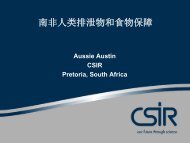
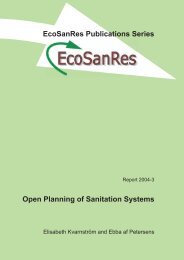

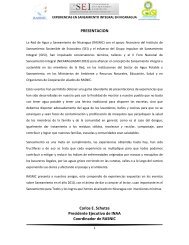
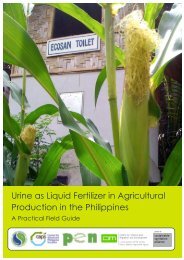

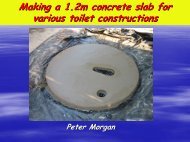
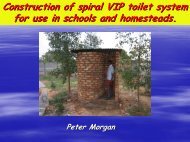
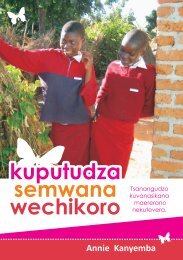
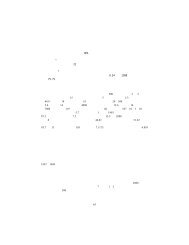
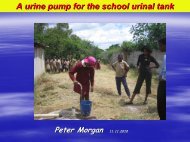
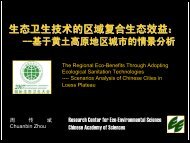
![Latrines à compost [high-resolution colour PDF: 12.3MB] - EcoSanRes](https://img.yumpu.com/31726141/1/185x260/latrines-a-compost-high-resolution-colour-pdf-123mb-ecosanres.jpg?quality=85)